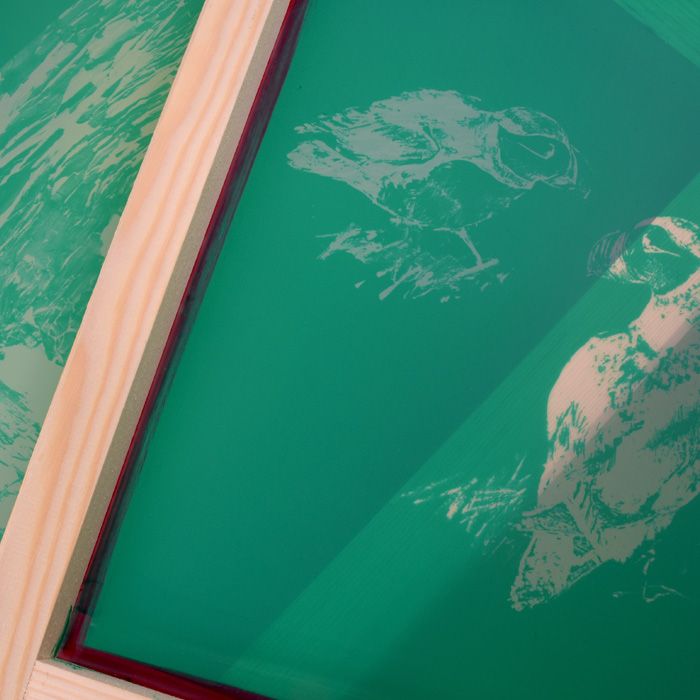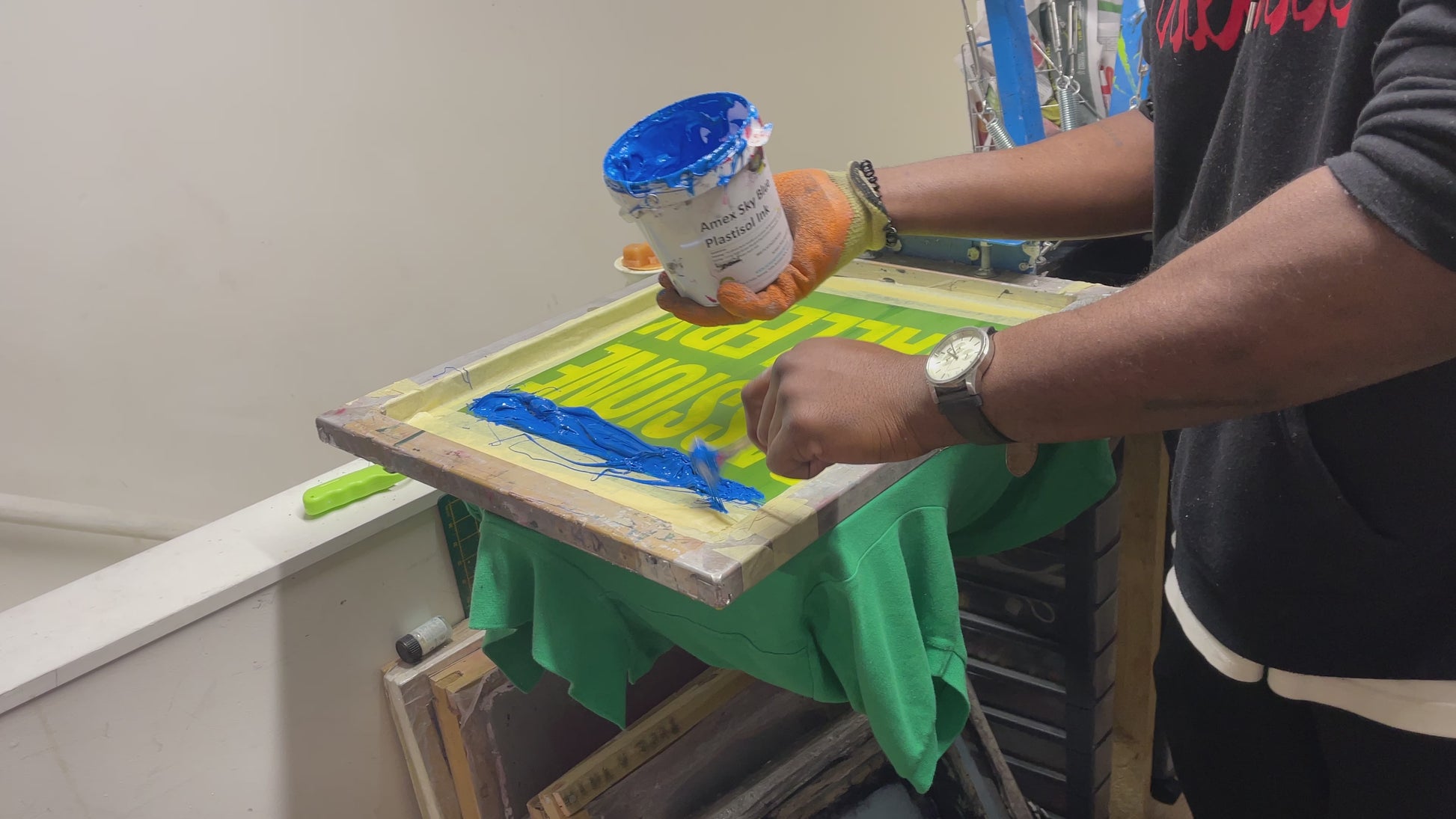Creative T-Shirt Printing Ideas for Small Brands
Wiki Article
Display Printing Uncovered: Everything You Need to Find Out About Tee Shirt and Garment Printing Strategies
Screen printing is an interesting method that combines art with technique, offering countless possibilities for imagination. Prepared to discover the essential aspects that make display publishing an art kind?
The Fundamentals of Display Printing: Just How It Functions
When you plunge into display printing, you'll discover it's both a scientific research and an art. At its core, display printing entails creating a pattern, or screen, that allows ink to travel through only in certain locations (screen printing kit). You start by selecting your layout and preparing your display with a light-sensitive emulsion. As soon as you reveal this solution to light, it sets, leaving your design as an adverse room.Next, you'll mix your inks and prepare your printing surface. Placement the display over the material, after that make use of a squeegee to press ink via the screen onto the garment. This process calls for precision, as you want clear, dynamic prints. After printing, you'll heal the ink with warmth, ensuring it complies with the textile and lasts via washes. Each step is important, and understanding them will boost your screen printing abilities, changing easy garments right into unique, expressive pieces.
Types of Display Printing Methods
When you realize the basics of screen printing, it's time to check out the different techniques that can elevate your layouts. One preferred method is typical screen printing, where ink is pushed with a stenciled display.If you're going for great information, consider discharge printing. This technique removes dye from the fabric, leaving a soft, classic look. An additional choice is plastisol printing, known for its toughness and vivid colors, making it a favorite for many brand names. Experiment with halftone printing to develop slope effects and detailed styles. Each method has its special appeal, so don't think twice to attempt them out to discover what matches your design best!
Important Devices for Screen Printing
To attain sensational results in display printing, having the appropriate equipment is basic. You'll require a strong screen printing framework, which holds the mesh that moves your style onto the garment. Next, spend in top notch squeegees; these are important for using ink uniformly throughout the screen.Choosing the Right Inks and Materials
When picking inks and products for display printing, you require to consider the type of ink that works ideal for your project. Think of material compatibility to assure your styles look last and wonderful long. Check out environment-friendly ink alternatives to make your printing procedure much more lasting.Kinds of Display Inks
Picking the ideal display ink is necessary for accomplishing dynamic, sturdy prints that satisfy your project's demands. There are a number of sorts of display inks to analyze. Plastisol ink is prominent for its adaptability and convenience of usage, offering excellent shade opacity on dark fabrics. Water-based ink, on the other hand, uses a softer feel and is environment-friendly, making it suitable for those seeking to decrease their ecological impact. Discharge inks get rid of dye from the material, causing a soft, vintage look yet require particular handling. Ultimately, specialty inks, such as glow-in-the-dark or metal, can include special impacts to your styles. Evaluate your job needs and pick the ink that lines up best with your preferred result.
Fabric Compatibility Considerations
Recognizing material compatibility is vital for achieving high-grade screen prints, specifically considering that various materials react uniquely to numerous inks. When selecting inks, consider the textile kind-- cotton, polyester, or blends. For cotton, water-based inks function well, providing soft qualities and breathability. Polyester, on the various other hand, frequently needs plastisol inks for much better adhesion and dynamic shades. You might require to make use of a combination of both kinds if you're publishing on blends. Constantly check your inks on example fabric to assure they adhere effectively and keep shade integrity. Additionally, bear in mind that material weight and appearance can impact the final result, so selecting the right ink and material combo is crucial for your task's success.Eco-Friendly Ink Options
Green inks are becoming a popular choice for display printers that wish to minimize their environmental effect while maintaining quality. When picking inks, take into consideration water-based inks, which are less unsafe and less complicated to tidy up contrasted to traditional solvents. These inks bond well with textiles, providing dynamic outcomes without harmful chemicals. You might likewise check out eco-solvent inks that use less unpredictable natural compounds (VOCs), making them a safer option for both your health and wellness and the world.Additionally, try to find inks made from renewable energies, such as soy or vegetable-based choices. By selecting the best inks and materials, you'll not only produce sensational styles but likewise add to a more lasting printing process. Make the switch, and your prints will certainly mirror your dedication to the environment!
Preparing Your Design for Display Printing

File Format Needs
To assure your style looks lively and sharp on material, you'll need to pay close focus to file style requirements for display printing. Make sure your design has a transparent history to protect against unwanted white sides on your prints. Maintain shade settings in mind; CMYK is standard for screen printing, so transform your RGB makes accordingly.Color Splitting Up Methods
Color splitting up is a necessary step in preparing your layout for screen printing, and mastering it can significantly enhance your print quality. You'll need to break your style right into individual colors, as each color needs a different display during printing. This precision not only guarantees exact shade representation however also simplifies the printing process.Resolution and Dimension
Achieving the most effective cause screen printing begins with guaranteeing your layout has the best resolution and dimension. Preferably, your artwork ought to be at least 300 DPI (dots per inch) for sharp, clear prints. Your final product could look unprofessional and custom screen printing pixelated. if you use reduced resolution.When it pertains to size, consider the measurements of your print area. Layout your artwork to match the last print dimension, ideally creating it in the real measurements you'll be publishing. In this manner, you'll avoid any type of unexpected scaling concerns.
Constantly inspect your design in both vector and raster formats. Vector graphics can be scaled without shedding top quality, making them ideal for screen printing. Preparing appropriately will assure your layout looks amazing on every garment!
Step-by-Step Display Printing Process
Screen printing is a vibrant procedure that permits you to develop vibrant designs on various surfaces. To start, you'll need a screen, emulsion, and your chosen ink. Prepare your display by cleaning it extensively. Next off, apply the solution evenly and allow it completely dry in a dark location. Once dry, expose your screen to light with your layout positioned on it, which will certainly solidify the emulsion where the light hits, producing a stencil - screen printing kit.After rinsing the unexposed emulsion, your display prepares. Set it up on your printing surface and align your garment under it. Put ink onto the screen and utilize a squeegee to push the ink through the pattern onto the material. Lift the display carefully and let the print completely dry. Cure the ink using warmth to ensure sturdiness. That's it! You've efficiently screen published your design.
Tips for Effective Screen Printing Projects
While you're diving right into your screen printing tasks, bear in mind that preparation is essential to success. Beginning by collecting all your materials-- inks, garments, mops, and displays. A clean work space helps stop unwanted errors, so clean before you start.Next, confirm your art work is high-resolution and effectively sized for your garment. Evaluate your display for proper exposure and tidy it thoroughly to prevent spots. When mixing your inks, adhere to the producer's standards to attain the appropriate consistency.
Throughout printing, apply even stress with your squeegee for constant results. Do not hurry; take your time to confirm each print fulfills your criteria. After printing, let your garments completely dry completely prior to managing or packaging them.
Lastly, constantly maintain an example of your benefit future referral. By doing this, you can assess your progression and improve your strategies in time. Satisfied printing!

Regularly Asked Inquiries
The length of time Does It Require To Establish up a Screen Printing Job?
Setting up a display printing job generally takes about 30 minutes to an hour. You'll prepare the screens, mix inks, and readjust journalism. The time varies based upon intricacy and experience, so stay organized!Can I Publish on Various Fabric Types Making Use Of the Very Same Method?
Yes, you can print on various textile kinds utilizing the same strategy, yet you'll need to adjust your settings and inks. Some textiles take in ink in different ways, so trying out guarantees the very best results for each product.What Are Common Blunders to Prevent in Screen Printing?
When display printing, prevent common blunders like utilizing the wrong ink, neglecting correct exposure times, or skipping pre-press checks. Constantly examine your arrangement and maintain clean screens to guarantee top quality outcomes each time.How Can I Appropriately Tidy and Maintain My Screen Printing Tools?
To correctly tidy and maintain your screen printing devices, you must consistently wash screens with proper solvents, examine squeegees for wear, and ensure all tools are kept completely dry and dust-free. Consistency enhances and protects against expensive fixings performance.Is Display Printing Ecologically Friendly Compared to Various Other Techniques?
Screen printing can be a lot more eco-friendly than other approaches, especially if you use eco-conscious products and water-based inks. By choosing sustainable products and techniques, you reduce waste and reduce your effect on the planet.Screen Printing Uncovered: Whatever You Required to Know Concerning Tee and Garment Printing Techniques
At its core, display printing includes developing a stencil, or screen, that permits ink to pass through only in particular areas. Setting the display over the textile, after that make use of a squeegee to press ink through the display onto the garment. One prominent technique is typical display printing, where ink is pressed via a stenciled display.When picking inks and products for display printing, you require to take right into account the kind of ink that functions ideal for your project.
Report this wiki page